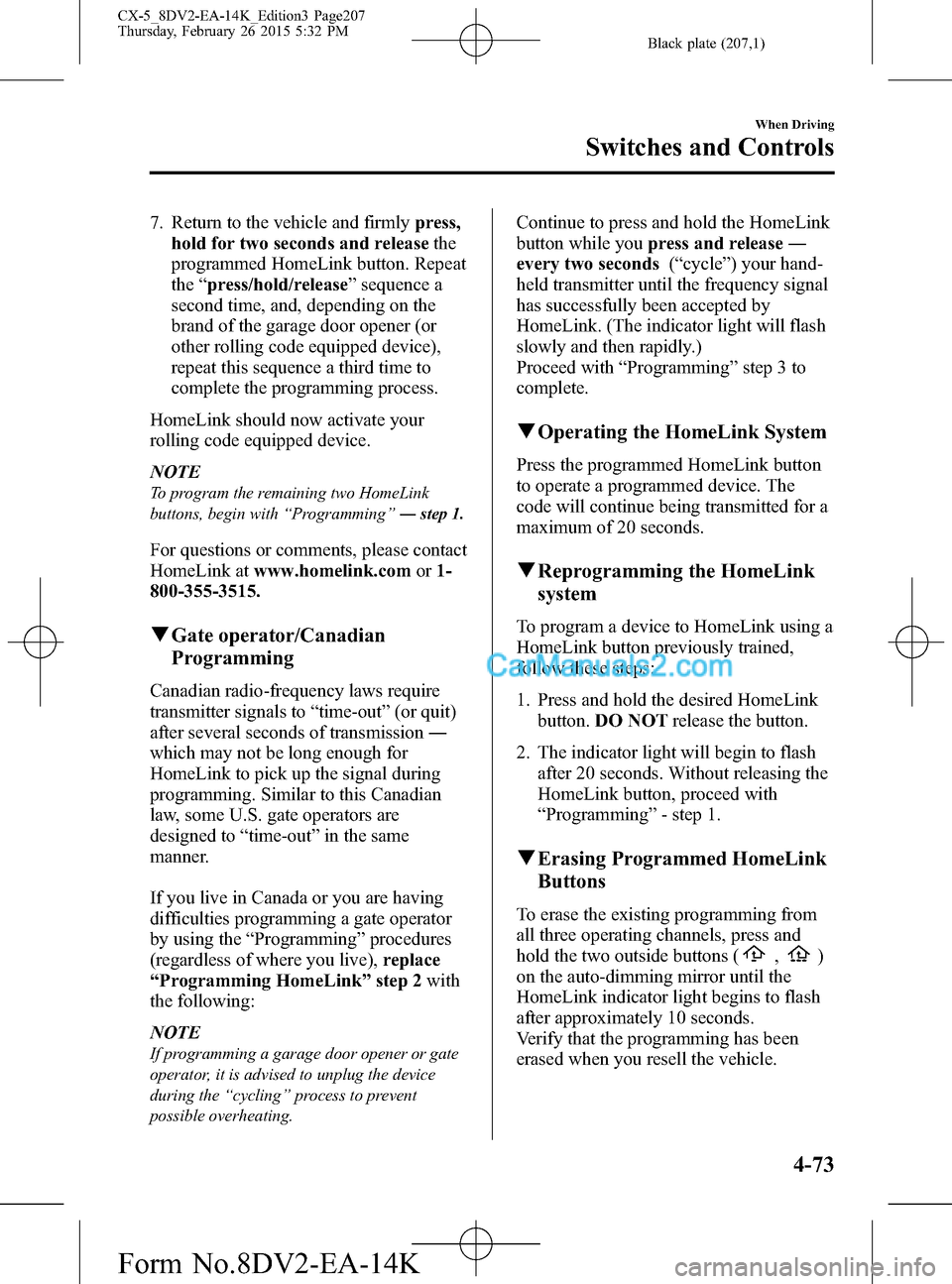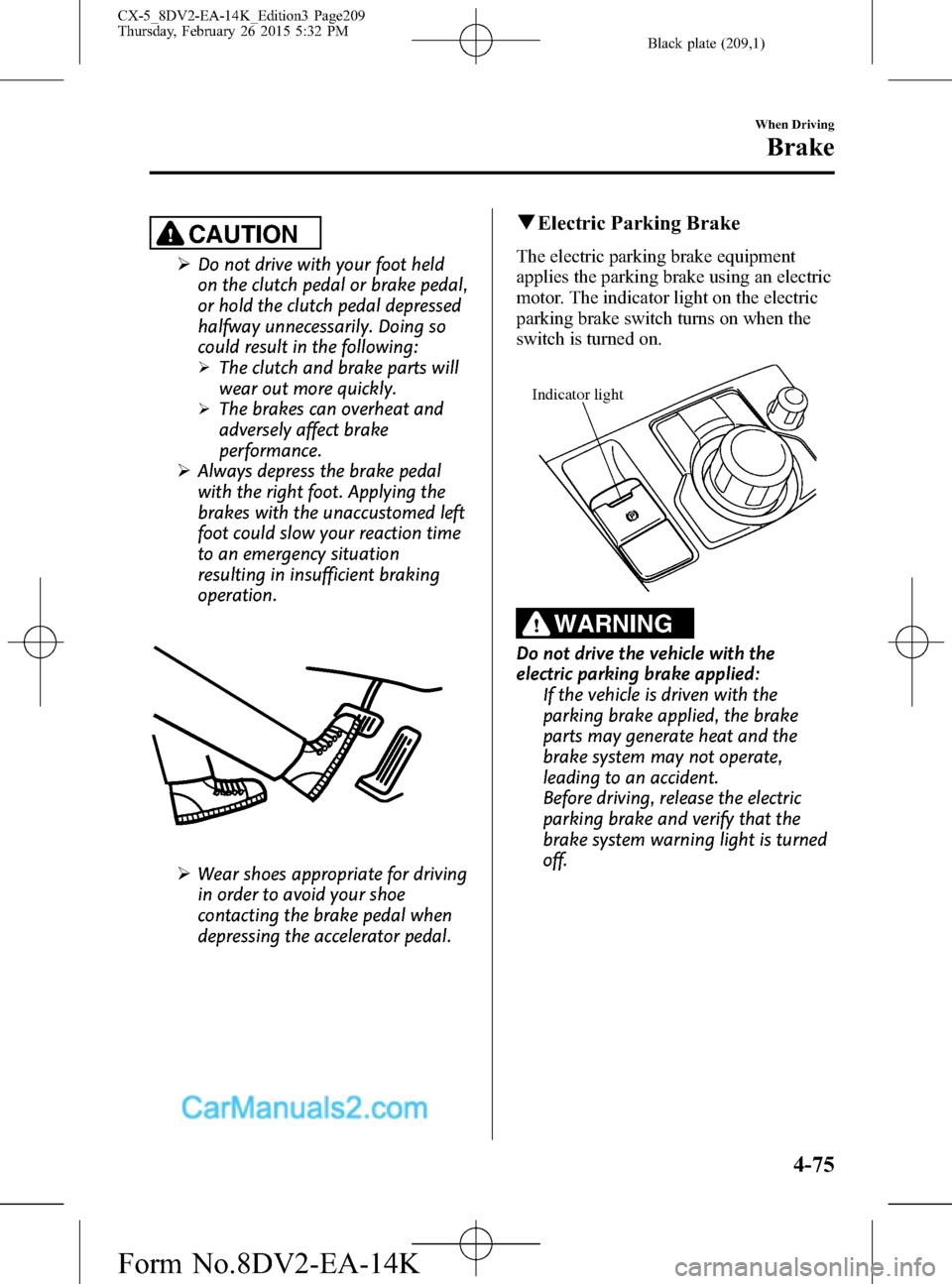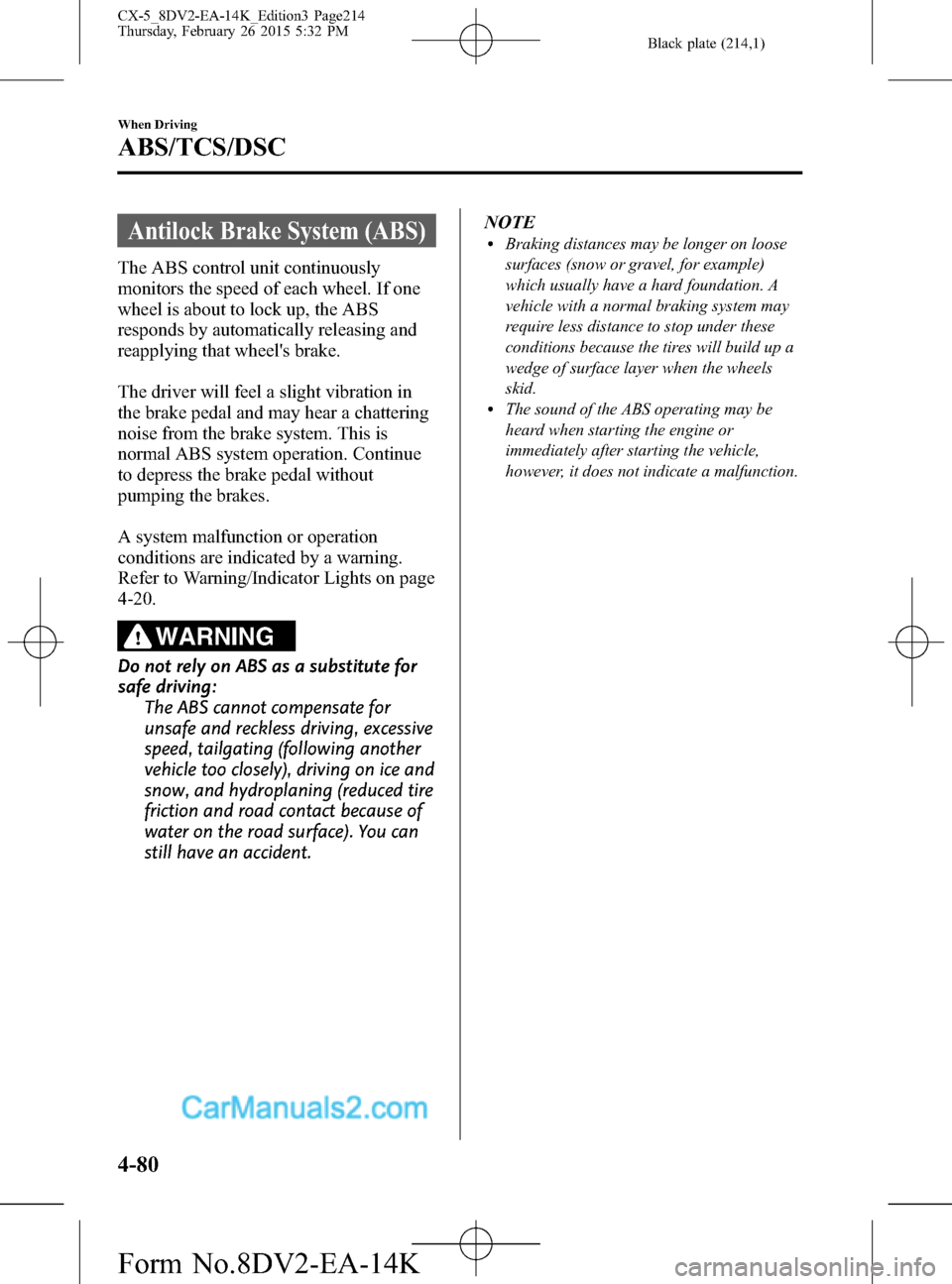light MAZDA MODEL CX-5 2016 Owners Manual (in English)
[x] Cancel search | Manufacturer: MAZDA, Model Year: 2016, Model line: MODEL CX-5, Model: MAZDA MODEL CX-5 2016Pages: 626, PDF Size: 13.81 MB
Page 207 of 626

Black plate (207,1)
7. Return to the vehicle and firmlypress,
hold for two seconds and releasethe
programmed HomeLink button. Repeat
the“press/hold/release”sequence a
second time, and, depending on the
brand of the garage door opener (or
other rolling code equipped device),
repeat this sequence a third time to
complete the programming process.
HomeLink should now activate your
rolling code equipped device.
NOTE
To program the remaining two HomeLink
buttons, begin with“Programming”―step 1.
For questions or comments, please contact
HomeLink atwww.homelink.comor1-
800-355-3515.
qGate operator/Canadian
Programming
Canadian radio-frequency laws require
transmitter signals to“time-out”(or quit)
after several seconds of transmission―
which may not be long enough for
HomeLink to pick up the signal during
programming. Similar to this Canadian
law, some U.S. gate operators are
designed to“time-out”in the same
manner.
If you live in Canada or you are having
difficulties programming a gate operator
by using the“Programming”procedures
(regardless of where you live),replace
“Programming HomeLink”step 2with
the following:
NOTE
If programming a garage door opener or gate
operator, it is advised to unplug the device
during the“cycling”process to prevent
possible overheating.
Continue to press and hold the HomeLink
button while youpress and release―
every two seconds(“cycle”) your hand-
held transmitter until the frequency signal
has successfully been accepted by
HomeLink. (The indicator light will flash
slowly and then rapidly.)
Proceed with“Programming”step 3 to
complete.
qOperating the HomeLink System
Press the programmed HomeLink button
to operate a programmed device. The
code will continue being transmitted for a
maximum of 20 seconds.
qReprogramming the HomeLink
system
To program a device to HomeLink using a
HomeLink button previously trained,
follow these steps:
1. Press and hold the desired HomeLink
button.DO NOTrelease the button.
2. The indicator light will begin to flash
after 20 seconds. Without releasing the
HomeLink button, proceed with
“Programming”- step 1.
qErasing Programmed HomeLink
Buttons
To erase the existing programming from
all three operating channels, press and
hold the two outside buttons (
,)
on the auto-dimming mirror until the
HomeLink indicator light begins to flash
after approximately 10 seconds.
Verify that the programming has been
erased when you resell the vehicle.
When Driving
Switches and Controls
4-73
CX-5_8DV2-EA-14K_Edition3 Page207
Thursday, February 26 2015 5:32 PM
Form No.8DV2-EA-14K
Page 208 of 626

Black plate (208,1)
Brake System
qFoot Brake
Your Mazda has power-assisted brakes
that adjust automatically through normal
use.
Should power-assist fail, you can stop by
applying greater force than normal to the
brake pedal. But the distance required to
stop will be greater than usual.
WARNING
Do not coast with the engine stalled or
turned off, find a safe place to stop:
Coasting with the engine stalled or
turned off is dangerous. Braking will
require more effort, and the brake's
power-assist could be depleted if you
pump the brake. This will cause
longer stopping distances or even an
accident.
Shift to a lower gear when going down
steep hills:
Driving with your foot continuously
on the brake pedal or steadily
applying the brakes for long
distances is dangerous. This causes
overheated brakes, resulting in
longer stopping distances or even
total brake failure. This could cause
loss of vehicle control and a serious
accident. Avoid continuous
application of the brakes.
Dry off brakes that have become wet
by driving slowly, releasing the
accelerator pedal and lightly applying
the brakes several times until the brake
performance returns to normal:
Driving with wet brakes is
dangerous. Increased stopping
distance or the vehicle pulling to one
side when braking could result in a
serious accident. Light braking will
indicate whether the brakes have
been affected.
4-74
When Driving
Brake
CX-5_8DV2-EA-14K_Edition3 Page208
Thursday, February 26 2015 5:32 PM
Form No.8DV2-EA-14K
Page 209 of 626

Black plate (209,1)
CAUTION
ØDo not drive with your foot held
on the clutch pedal or brake pedal,
or hold the clutch pedal depressed
halfway unnecessarily. Doing so
could result in the following:
ØThe clutch and brake parts will
wear out more quickly.
ØThe brakes can overheat and
adversely affect brake
performance.
ØAlways depress the brake pedal
with the right foot. Applying the
brakes with the unaccustomed left
foot could slow your reaction time
to an emergency situation
resulting in insufficient braking
operation.
ØWear shoes appropriate for driving
in order to avoid your shoe
contacting the brake pedal when
depressing the accelerator pedal.
qElectric Parking Brake
The electric parking brake equipment
applies the parking brake using an electric
motor. The indicator light on the electric
parking brake switch turns on when the
switch is turned on.
Indicator light
WARNING
Do not drive the vehicle with the
electric parking brake applied:
If the vehicle is driven with the
parking brake applied, the brake
parts may generate heat and the
brake system may not operate,
leading to an accident.
Before driving, release the electric
parking brake and verify that the
brake system warning light is turned
off.
When Driving
Brake
4-75
CX-5_8DV2-EA-14K_Edition3 Page209
Thursday, February 26 2015 5:32 PM
Form No.8DV2-EA-14K
Page 210 of 626

Black plate (210,1)
NOTElThe electric parking brake cannot be
applied or released while the vehicle
battery is dead.
lIf the electric parking brake is repeatedly
applied and released it may stop operating
to prevent overheating of the motor. If this
occurs, wait approx. 1 minute before
operating the electric parking brake switch
again.
lAn operation sound occurs when applying
or releasing the electric parking brake,
however, this does not indicate a
malfunction.
lIf the electric parking brake is not used for
long periods, an automatic inspection of the
system is performed while the vehicle is
parked. An operation sound can be heard,
however, this does not indicate a problem.
lWhen the electric parking brake is applied
and the ignition is switched OFF, an
operation sound can be heard, however,
this does not indicate a problem.
lThe brake pedal may move while the
electric parking brake is being applied or
released, however, this does not indicate a
problem.
lIf the electric parking brake switch is
continually pulled while driving the vehicle,
the electric parking brake will be applied
and the electric parking brake warning
beep will be activated. When the switch is
released, the electric parking brake is
released and the beep stops.
lIf the electric parking brake is applied with
the ignition switched off or in ACC, the
brake system warning light in the
instrument cluster and the indicator light in
the switch may turn on for 15 seconds.
lWhen running the vehicle through an
automatic car wash, it may be necessary to
switch the ignition off with the parking
brake released depending on the type of
automatic car wash.
When applying the electric parking
brake
The electric parking brake can be applied
regardless of the ignition switch position.
Securely depress the brake pedal and pull
up the electric parking brake switch.
The electric parking brake is applied and
the brake system warning light and the
electric parking brake switch indicator
light turn on.
Refer to Warning/Indicator Lights on page
4-20.
When releasing the electric parking
brake
The electric parking brake can be released
while the ignition is switched ON or the
engine is running. When the electric
parking brake is released, the brake
system warning light and the electric
parking brake switch indicator light turn
off.
4-76
When Driving
Brake
CX-5_8DV2-EA-14K_Edition3 Page210
Thursday, February 26 2015 5:32 PM
Form No.8DV2-EA-14K
Page 211 of 626

Black plate (211,1)
Electric parking brake manual release
Securely depress the brake pedal and
press the electric parking brake switch.
Electric parking brake automatic
release
If the accelerator pedal is depressed with
the electric parking brake applied and all
of the following conditions met, the
parking brake is released automatically.
lThe engine is running.lThe driver's door is closed.lThe driver's seat belt is fastened.
(Manual transaxle)
lThe change lever is in a position other
than neutral.
lThe clutch pedal is depressed halfway
(Automatic transaxle)
lSelector lever is in the D, M, or R
position
NOTE
If something such as the driver's foot contacts
the accelerator pedal with the engine running
and the electric parking brake applied, the
parking brake may be released automatically.
If you do not intend to drive immediately, shift
the change lever (manual transmission) to the
neutral position, or shift the selector lever
(automatic transmission) to the P or N
position.
qDisplay Indication
For vehicles with the type A instrument
cluster, check the vehicle condition or
have the vehicle inspected at an
Authorized Mazda Dealer according to
the indication.
qWarning Light
A system malfunction or operation
conditions are indicated by a warning.
Refer to Warning/Indicator Lights on page
4-20.
qBrake Pad Wear Indicator
When the disc brake pads become worn,
the built-in wear indicators contact the
disc plates. This causes a screeching noise
to warn that the pads should be replaced.
When you hear this noise, consult an
Authorized Mazda Dealer as soon as
possible.
WARNING
Do not drive with worn disc pads:
Driving with worn disc pads is
dangerous. The brakes could fail and
cause a serious accident. As soon as
you hear a screeching noise consult
an Authorized Mazda Dealer.
When Driving
Brake
4-77
CX-5_8DV2-EA-14K_Edition3 Page211
Thursday, February 26 2015 5:32 PM
Form No.8DV2-EA-14K
Page 213 of 626

Black plate (213,1)
WARNING
Do not rely completely on Hill Launch
Assist (HLA):
Hill Launch Assist (HLA) is an
auxiliary device for accelerating from
a stop on a slope. The system only
operates for about two seconds and
therefore, relying only on the system,
when accelerating from a stop is
dangerous because the vehicle may
move (roll) unexpectedly and cause
an accident.
The vehicle could roll depending on
the vehicle's load or if it is towing
something. In addition, for vehicles
with a manual transaxle, the vehicle
could still roll depending on how the
clutch pedal or the accelerator pedal
is operated.
Always confirm the safety around the
vehicle before starting to drive the
vehicle.NOTE
lHill Launch Assist (HLA) does not operate
on a gentle slope. In addition, the gradient
of the slope on which the system will
operate changes depending on the vehicle's
load.
lHill Launch Assist (HLA) does not operate
if the parking brake is applied, the vehicle
has not stopped completely, or the clutch
pedal is released.
lWhile Hill Launch Assist (HLA) is
operating, the brake pedal may feel stiff
and vibrate, however, this does not indicate
a malfunction.
lHill Launch Assist (HLA) does not operate
while the TCS/DSC indicator light is
illuminated.
Refer to Warning/Indicator Lights on page
4-20.
lHill Launch Assist (HLA) does not turn off
even if the TCS OFF switch is pressed to
turn off the TCS.
When Driving
Brake
4-79
CX-5_8DV2-EA-14K_Edition3 Page213
Thursday, February 26 2015 5:32 PM
Form No.8DV2-EA-14K
Page 214 of 626

Black plate (214,1)
Antilock Brake System (ABS)
The ABS control unit continuously
monitors the speed of each wheel. If one
wheel is about to lock up, the ABS
responds by automatically releasing and
reapplying that wheel's brake.
The driver will feel a slight vibration in
the brake pedal and may hear a chattering
noise from the brake system. This is
normal ABS system operation. Continue
to depress the brake pedal without
pumping the brakes.
A system malfunction or operation
conditions are indicated by a warning.
Refer to Warning/Indicator Lights on page
4-20.
WARNING
Do not rely on ABS as a substitute for
safe driving:
The ABS cannot compensate for
unsafe and reckless driving, excessive
speed, tailgating (following another
vehicle too closely), driving on ice and
snow, and hydroplaning (reduced tire
friction and road contact because of
water on the road surface). You can
still have an accident.NOTE
lBraking distances may be longer on loose
surfaces (snow or gravel, for example)
which usually have a hard foundation. A
vehicle with a normal braking system may
require less distance to stop under these
conditions because the tires will build up a
wedge of surface layer when the wheels
skid.
lThe sound of the ABS operating may be
heard when starting the engine or
immediately after starting the vehicle,
however, it does not indicate a malfunction.
4-80
When Driving
ABS/TCS/DSC
CX-5_8DV2-EA-14K_Edition3 Page214
Thursday, February 26 2015 5:32 PM
Form No.8DV2-EA-14K
Page 215 of 626

Black plate (215,1)
Traction Control System
(TCS)
The Traction Control System (TCS)
enhances traction and safety by
controlling engine torque and braking.
When the TCS detects driving wheel
slippage, it lowers engine torque and
operates the brakes to prevent loss of
traction.
This means that on a slick surface, the
engine adjusts automatically to provide
optimum power to the drive wheels,
limiting wheel spin and loss of traction.
A system malfunction or operation
conditions are indicated by a warning.
Refer to Warning/Indicator Lights on page
4-20.
WARNING
Do not rely on the Traction Control
System (TCS) as a substitute for safe
driving:
The Traction Control System (TCS)
cannot compensate for unsafe and
reckless driving, excessive speed,
tailgating (following another vehicle
too closely), and hydroplaning
(reduced tire friction and road
contact because of water on the road
surface). You can still have an
accident.
Use snow tires or tire chains and drive
at reduced speeds when roads are
covered with ice and/or snow:
Driving without proper traction
devices on snow and/or ice-covered
roads is dangerous. The Traction
Control System (TCS) alone cannot
provide adequate traction and you
could still have an accident.
NOTE
To turn off the TCS, press the TCS OFF switch
(page 4-82).
When Driving
ABS/TCS/DSC
4-81
CX-5_8DV2-EA-14K_Edition3 Page215
Thursday, February 26 2015 5:32 PM
Form No.8DV2-EA-14K
Page 216 of 626

Black plate (216,1)
qTCS OFF Switch
Press the TCS OFF switch to turn off the
TCS. The TCS OFF indicator light in the
instrument cluster will illuminate.
Press the switch again to turn the TCS
back on. The TCS OFF indicator light
will turn off.
NOTE
lWhen TCS is on and you attempt to free the
vehicle when it is stuck, or drive it out of
freshly fallen snow, the TCS will activate.
Depressing the accelerator will not
increase engine power and freeing the
vehicle may be difficult. When this happens,
turn off the TCS.
lIf the TCS is off when the engine is turned
off, it automatically activates when the
ignition is switched ON.
lLeaving the TCS on will provide the best
traction.
lIf the TCS OFF switch is pressed and held
for 10 seconds or more, the TCS OFF
switch malfunction detection function
operates and the TCS system activates
automatically. The TCS OFF indicator light
turns off while the TCS system is operative.
Dynamic Stability Control
(DSC)
The Dynamic Stability Control (DSC)
automatically controls braking and engine
torque in conjunction with systems such
as ABS and TCS to help control side slip
when driving on slippery surfaces, or
during sudden or evasive maneuvering,
enhancing vehicle safety.
Refer to ABS (page 4-80) and TCS (page
4-81).
DSC operation is possible at speeds
greater than 20 km/h (12 mph).
A system malfunction or operation
conditions are indicated by a warning.
Refer to Warning/Indicator Lights on page
4-20.
WARNING
Do not rely on the Dynamic Stability
Control as a substitute for safe driving:
The Dynamic Stability Control (DSC)
cannot compensate for unsafe and
reckless driving, excessive speed,
tailgating (following another vehicle
too closely), and hydroplaning
(reduced tire friction and road
contact because of water on the road
surface). You can still have an
accident.
4-82
When Driving
ABS/TCS/DSC
CX-5_8DV2-EA-14K_Edition3 Page216
Thursday, February 26 2015 5:32 PM
Form No.8DV2-EA-14K
Page 220 of 626

Black plate (220,1)
Drive Selection (Automatic Transaxle)
Drive selection is a system to switch the vehicle's drive mode. When the sport mode is
selected, vehicle's response against accelerator operation is enhanced. This provides
additional quick acceleration which may be needed to safely make maneuvers such as lane
changes, merging onto freeways, or passing other vehicles.
CAUTION
Do not use the sport mode when driving on slippery roads such as wet or snow-
covered roads. It may cause tire slipping.
NOTE
lWhen the sport mode is selected, driving at higher engine speeds increases and it may increase
fuel consumption. Mazda recommends to cancel the sport mode on normal driving.
lDrive mode cannot be switched in the following conditions:lABS/TCS/DSC is operatinglThe Mazda Radar Cruise Control (MRCC) system/cruise control is operating.lSteering wheel is being operated abruptly
qDrive Selection Switch
Press the drive selection switch to the
side (forward) to select the sport
mode.
Pull the drive selection switch to the
side (backward) to cancel the sport mode.
NOTElWhen the ignition is switched off, the sport
mode is canceled.
lDepending on the driving conditions when
sport mode is selected, the vehicle may
perform shift-down or slightly accelerate.
qSelect Mode Indication
When the sport mode is selected, the
select mode indication turns on in the
instrument cluster.
NOTE
If the mode cannot be switched to drive mode,
the select mode indication flashes to notify the
driver.
4-86
When Driving
Drive Selection
CX-5_8DV2-EA-14K_Edition3 Page220
Thursday, February 26 2015 5:32 PM
Form No.8DV2-EA-14K